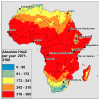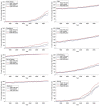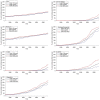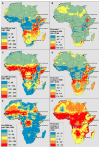Regional Projections of Extreme Apparent Temperature Days in Africa and the Related Potential Risk to Human Health
- PMID: 26473895
- PMCID: PMC4626987
- DOI: 10.3390/ijerph121012577
Regional Projections of Extreme Apparent Temperature Days in Africa and the Related Potential Risk to Human Health
Abstract
Regional climate modelling was used to produce high resolution climate projections for Africa, under a "business as usual scenario", that were translated into potential health impacts utilizing a heat index that relates apparent temperature to health impacts. The continent is projected to see increases in the number of days when health may be adversely affected by increasing maximum apparent temperatures (AT) due to climate change. Additionally, climate projections indicate that the increases in AT results in a moving of days from the less severe to the more severe Symptom Bands. The analysis of the rate of increasing temperatures assisted in identifying areas, such as the East African highlands, where health may be at increasing risk due to both large increases in the absolute number of hot days, and due to the high rate of increase. The projections described here can be used by health stakeholders in Africa to assist in the development of appropriate public health interventions to mitigate the potential health impacts from climate change.
Keywords: Africa; climate change; climate services; human health; regional climate modelling.
Figures








References
-
- Collins J.M. Temperature variability over Africa. J. Clim. 2011;24:3649–3666. doi: 10.1175/2011JCLI3753.1. - DOI
-
- Niang I., Ruppel O.C., Abdrabo M.A., Essel A., Lennard C., Padgham J., Urquhart P. Africa. In: Barros V.R., Field C.B., Dokken D.J., Mastrandrea M.D., Mach K.J., Bilir T.E., Chatterjee M., Ebi K.L., Estrada Y.O., Genova R.C., et al., editors. Climate change 2014: Impacts, Adaptation, and Vulnerability. Part B: Regional Aspects. Contribution of Working Group II to the Fifth Assessment Report of the Intergovernmental Panel of Climate Change. Cambridge University Press; Cambridge, UK; New York, NY, USA: 2014. pp. 1199–1265.
-
- Kilbourne E.M. Heat waves and hot environments. In: Noji E.K., editor. The Public Health Consequences of Disasters. Oxford University Press; New York, NY, USA: 1997.
Publication types
MeSH terms
LinkOut - more resources
Full Text Sources
Other Literature Sources
Medical

